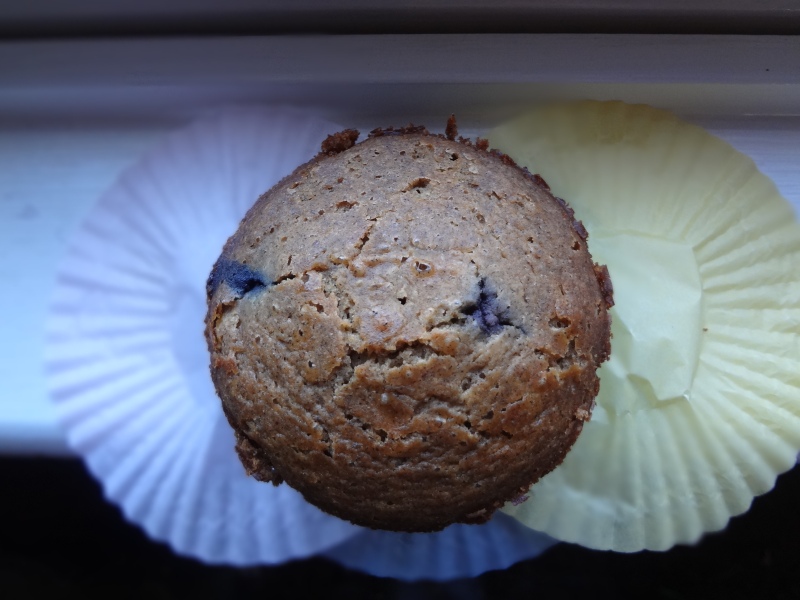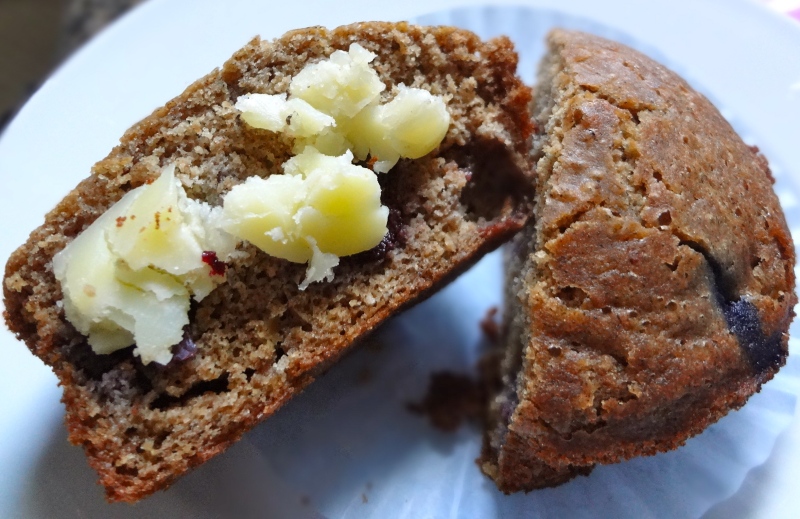When I go home for a visit, which is almost always in summer, I eat blueberries to my heart’s content. They always make the list.
Blueberries, or “bru-berries” as my sisters and I would say as kids, remind me of my childhood. We inherited this little nondescript bush in the backyard that for a few months a year would give up the most incredible blueberries which we immediately scarfed down or turned into sugary summer pies. Blueberries were a summer thing.
By some odd and unusual turn of events, We happened to have some left over from last week’s market and they were starting to look pretty pathetic and in desperate need of inspiration. I wanted something a bit more wholesome than those sugar-laced pies, something I could relish in my mouth and feel good about an hour afterward. A recipe was found and a recipe was tweaked. Buckwheat and millet flour were sitting nicely on the first shelf in the fridge. Not far away were the coconut oil and some maple syrup. And there I had it: a delicious, wholesome muffin to feel good about.
I could just leave it here, telling you how good they are for you and not explaining myself a bit. But wouldn’t it be even better to know such things like why it’s worth it to substitute the typical wheat flour for buckwheat? And why blueberries and buckwheat make such a dynamic duo? Curious yet?
Buckwheat is not to be confused with wheat, in fact they aren’t even in the same family. It is considered a fruit seed, sharing ties with rhubarb and sorrel and doesn’t contain any of the gluten proteins that grains do. Gluten-free through and through. Unlike grains, which tend to be deficient in essential amino acid lysine, buckwheat contains all 8 essential amino acids, making it a complete and valuable source of protein. It’s also contains valuable B vitamins and lots of tryptophan, an amino acid known to promote relaxation and rest. Think post-Thanksgiving turkey bliss (another food high in tryptophan).
Blueberries are one of the touted super foods we hear about so often and with good reason. They are chock full of phytonutrients with antioxidant and anti-inflammatory properties, vitamin C, fiber and vitamin K, know for its’ role in bone health.
So I ask: What do a blueberries and buckwheat have in common? Anyone? As it turns out, a whole lot:
1. Antioxidants and the cardiovascular system
Both buckwheat and blueberries do wonders to help out with cholesterol, high blood pressure and blood sugar. Buckwheat contains Rutin, a flavenoid that acts as an antioxidant, increasing blood flow and protecting LDL (“bad” cholesterol) from free radical oxidation. It’s also high in Magnesium and Copper, two minerals that are known to help manage the levels of insulin and glucose in the body. But the superstar here is a little guy they refer to as chiro-inositol. It actually makes cells more sensitive to insulin and has been effective in lowering glucose levels in Type 2 diabetes in animals. Pretty amazing!
Blueberries have incredible protective properties when it comes to the cardiovascular system. Super antioxidants (containing a whole range of ‘em), they work on nearly every system of the body but do some of their best when it comes to keeping that blood flowing right. Protecting against oxidation, lowering LDL cholesterol (“bad” guy) and increasing HDL cholesterol (our friend) and reducing total cholesterol are only a few of the benefits seen with daily consumption of these little beauties.
2. Fiber
FIBER, FIBER, FIBER! I cannot emphasize enough how important fiber is to a healthy diet and how lacking it is in the western diet. Fiber helps lower cholesterol, protects against cancer, serves as food for our friendly gut flora, slows the release of sugar into the bloodstream and helps you feel full with less and for longer! Both Buckwheat and Blueberries are considered a low glycemic (the sugars are released slowly overtime into the bloodstream and don’t overwork insulin production) food because of their fiber content, known to protect against degenerative disease such as diabetes, metabolic syndrome and obesity, all linked to high glycemic diets which create insulin resistance in the long run. That’s good news for diabetics and anyone looking out for their long term health.
One cup of buckwheat contains 5 grams of fiber, almost half the daily recommendation for fiber. Pair that with 2 cups of blueberries (3.9 grams/cup) and you’ve got it taken care of.
3. Manganese
Manganese is no small chicken, although its’ status as a trace mineral might make you think otherwise. It comes into play in bone health and regulates blood sugar levels. It’s known as an enzyme activator, without which things like the synthesize of fatty acids, functions of the thyroid gland and the central nervous system wouldn’t happen.
One cup of blueberries brings in 25% of your daily needs, with 0.50mg and buckwheat tops that with at 34%, with 0.68mg. Stellar team work right there.
Now, I have to tell you a little inconvenient truth: when you heat or cook food, especially over 350 degrees (180 C), you are usually doing so at the loss of some enzymes and nutrients. This is most definitely true in the case of blueberries and their super antioxidants. I recommend baking/cooking with them occasionally and the rest of the time committing to eating them raw in large handfuls, on top of yogurt, in smoothies or wherever else you may think of. It’s not a hard sacrifice to make, I promise.
These are gluten-free and as such will not rise and fluff like a classic muffin. For those of you who are into the dense, hearty, slightly sweet kind that only takes one to get the day started right, this is your muffin. Try it with some ghee (clarified butter), jam or both slathered on top.
Recipe
Adapted from the New York Times Recipes for Health by Martha Rose Schulman
1 cup buckwheat flour*
1 cup millet flour* (or all purpose gluten-free mix, if available)
1 tsp baking soda
2 tsp baking powder
1 tsp salt
1 cup blueberries* (I used about 1 1/2)
1/3 cup maple syrup (or agave, honey, etc)
1 1/2 cups almond milk
1/3 cup coconut oil
2 farm fresh, free range eggs
juice of 1/2 lemon (or more, to taste)
zest of 1 lemon*
1 tbsp poppy seeds
Preheat the oven to 375 degrees with the rack adjusted to the middle. Oil or paper muffin tins. Sift together the flours, baking powder, baking soda and salt into a medium bowl. Add any grainy bits remaining in the sifter to the bowl.
In a separate bowl beat together the eggs, maple syrup, almond milk, coconut oil, lemon zest and lemon juice. Whisk in the dry ingredients and mix until well combined, but take care not to beat it too long. Fold in the blueberries and poppy seeds.
Take a tablespoon and fill muffin cups to the top. Place in the oven and bake 25 to 30 minutes, until lightly browned and well risen. Remove from the heat and take the muffins out of the tin, letting them cool on a wire rack. If they don’t come out easily, let them cool down before removing them from the muffin tins.
*I try to use 100% organic materials but I understand that may not be within everyone’s reach. If you have to select just a few, make sure at least the blueberries, lemon and flours are organic. Blueberries and lemons are usually sprayed heavily with pesticides and fungicides and since we aren’t taking off their skins here, it’s all going in. Flour from whole grains contains the whole grain seed, including the bran (outermost part), meaning that everything that it has been sprayed with will end up in your muffin.
Receta
140 g/1 taza harina de trigo sarraceno
140g/ 1 taza harina de mijo (o de harina sin gluten o de arroz integral)
5g/1 c.p. bicarbonato sódico
10g/2 c.p. levadura
3,5g/.5 c.p. sal
170g / 1 taza arándanos azules
125g/ 1/3 taza sirope de arce ( o agave, miel, etc)
360g / 1.5 tazas leche de almendras
75g / 1/3 taza aceite de coco (o ghee)
2 huevos camperos, de número 0 o 1
Piel de limón, rallada
Zumo de medio limón
1 c.s. de semillas de amapola
Calentar el horno a 190 C. Untar el molde para la s magdalenas o forrarlo con papelitos. Tamizar en un bol las harinas, la levadura, el bicarbonato sódico y la sal para evitar grumos. Añadir al bol los restos que pueden quedar en el colador.
En otro bol, con la ayuda de un batidor, mezclar los huevos, el sirope, la leche, el aceite, la piel de limón rallada y el zumo del mismo hasta que tengan una consitencia uniforme. Añadir poco a poco los ingredientes secos y mezclar hasta que se combinen, pero sin batir mucho rato. Incoporar los arándanos y las semillas de amapola.
Con una cuchara, llenar hasta arriba el molde con la mezcla. Meterlo al horno y dejar 25-30 minutos, hasta que la masa de las magdalenas suba y quede dorada. Sacar las magadelenas del horno para que se enfríen, preferiblemente sin el molde. Si ves que la masa se pega con el molde, deja enfriar las magadalenas en él.


